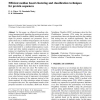124
click to vote
NAR
2007
15 years 7 days ago
2007
The Universal Protein Resource (UniProt) provides the scientific community with a single, centralized, authoritative resource for protein sequences and functional information. For...
114
click to vote
NAR
2002
2002
The Protein Information Resource: an integrated public resource of functional annotation of proteins
15 years 11 days ago
The Protein Information Resource (PIR) serves as an integrated public resource of functional annotation of protein data to support genomic/proteomic research and scientific discov...
91
Voted
NAR
2002
15 years 12 days ago
2002
The AraC-XylS database contains information about a family of positive transcriptional regulators broadly distributed in bacteria. This specific database focuses on protein sequen...
98
Voted
BMCBI
2005
15 years 19 days ago
2005
Background: Whole-genome sequencing projects are rapidly producing an enormous number of new sequences. Consequently almost every family of proteins now contains hundreds of membe...
124
Voted
BMCBI
2005
15 years 19 days ago
2005
Background: General protein evolution models help determine the baseline expectations for the evolution of sequences, and they have been extensively useful in sequence analysis an...
100
Voted
PR
2006
15 years 20 days ago
2006
The annotation of proteins can be achieved by classifying the protein of interest into a certain known protein family to induce its functional and structural features. This paper ...
102
click to vote
PAA
2006
15 years 20 days ago
2006
Abstract In this paper, an efficient K-medians clustering (unsupervised) algorithm for prototype selection and Supervised K-medians (SKM) classification technique for protein seque...
107
click to vote
NAR
2006
15 years 20 days ago
2006
The FISH server is highly accurate in identifying the family membership of domains in a query protein sequence, even in the case of very low sequence identities to known homologue...
114
click to vote
BMCBI
2007
15 years 22 days ago
2007
Background: We performed an exhaustive search for local structural similarities in an ensemble of non-redundant protein functional sites. With the purpose of finding new examples ...
134
click to vote
BMCBI
2007
15 years 22 days ago
2007
Background: Identification of protein interacting sites is an important task in computational molecular biology. As more and more protein sequences are deposited without available...





